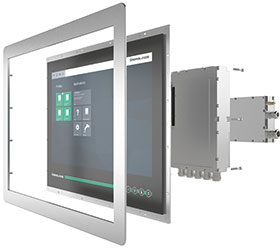

HMI components and solutions are in use in all sectors of the process industry today and the requirements they must meet in the highly specialised sectors of the chemical, pharmaceutical or oil and gas industries are high. Insensitivity to harsh environmental conditions, vibration, or temperature fluctuations is a decisive factor in the chemicals industry, for instance. By contrast, low surface roughness of the stainless steel housing and good cleanability in accordance with GMP guidelines is of particular importance in the life sciences sector. Devices that are expected to survive in these demanding environments must be precisely tailored to the respective requirements to provide the user with the best possible support in their plant control. This especially applies where potentially explosive production areas pose an additional challenge.
But it is not only the difficult environmental conditions that place high demands on modern HMI solutions. As the level of automation in process plants constantly increases, so too do the requirements placed on the underlying computer infrastructure. For this reason, alongside the increasing digitisation and networking of automation systems, thin client technology is becoming increasingly important in today’s production plants. The enormous potential of this technology was recognised early on at Pepperl+Fuchs. Back in 2007, the company launched its first network-based thin client solution for hazardous areas with the VisuNet Remote Monitor (RM).
Thin client technology has spread rapidly since then, but today’s solutions are generally still characterised by a monolithic design. That is, a computer, display and power supply often form a closed unit. In daily operation this certainly has disadvantages, because this design often results in a high unit weight, thus making handling more difficult in practice. This makes even just installing the heavy units more complex. This problem persists when a simple component upgrade is due, or repairs are necessary. The entire system must then be dismantled and sent back to the manufacturer, requiring a significant amount of technical and logistical work.
A new generation of thin client
The future of thin-client-based HMIs for hazardous areas should look very different – namely compact, lightweight and modular. An example of this is the VisuNet GXP Remote Monitor from Pepperl+Fuchs. This monitor-based solution for Zone 1/21 weighs less than 25 kilograms, which enables one-person installation and fast commissioning. The compact, modular design is also of great benefit in everyday handling. Each unit consists of three main components: the display, the power supply, and the specially designed thin client computer unit. In case of a defect, the operator can replace the components separately thanks to the modular design. In this way, onsite servicing is simplified and operation can be resumed quickly.
That nothing has been spared in terms of display size, despite the light weight is crucial for the optimal visualisation of processes. A 21,5” full HD display in 16:9 widescreen format enables the direct transfer of process control images. To ensure minimal reflections and optimum image viewing, the displays also have an anti-reflective coating. A projected capacitive multi-touch sensor behind safety glass enables the configuration of touch-optimised user interfaces using gestures and cursor control, as is familiar from a smartphone or tablet PC. This means that important safety aspects can be implemented for critical processes. For example, it is possible to specify that functions only start when two contact points are touched simultaneously, to avoid unintentional activation. A powerful and reliable DC or AC power supply ensures that a wide range of applications is covered. The design of the components also fulfils the specific demands of highly specialised industries like chemicals and pharmaceuticals, as the stainless steel surfaces and the gap-free design of the enclosure and keyboard prevent the accumulation of liquids, dirt and bacteria. At the same time, they ensure optimal cleaning and even comply with the stringent GMP guidelines.
Thanks to the compact, modular design, the new generation of thin-client-based HMI systems offers considerable benefits for process automation. The light weight facilitates handling in daily operation and enables a significantly faster installation and more efficient servicing of the units. Large displays also enable the direct transfer of process control images, and therefore optimum visualisation.
| Tel: | +27 10 430 0250 |
| Fax: | 086 756 8741 |
| Email: | info@za.pepperl-fuchs.com |
| www: | www.pepperl-fuchs.co.za |
| Articles: | More information and articles about Pepperl+Fuchs |
© Technews Publishing (Pty) Ltd | All Rights Reserved